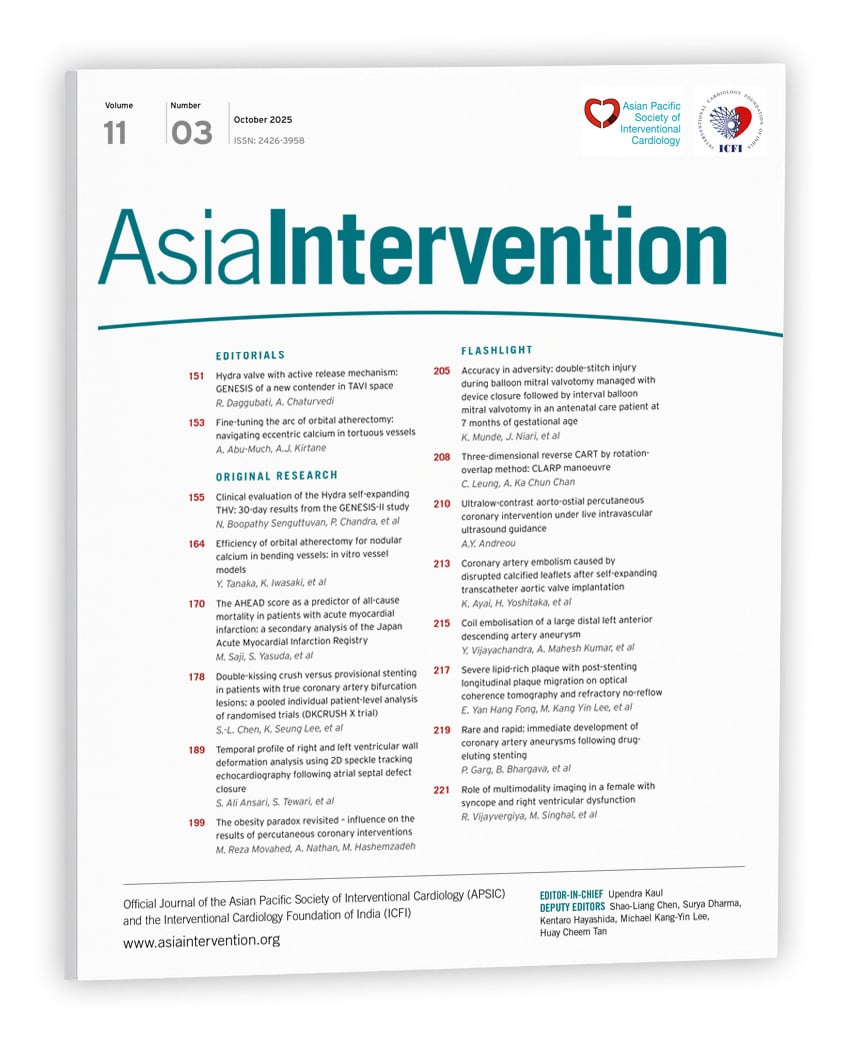We present a 60-year-old male with longitudinal migration of lipid-rich plaque demonstrated on optical coherence tomography (OCT). The patient had a history of hypertension and presented to the outpatient clinic with an exercise intolerance of 6 months’ duration. Coronary computed tomography angiogram showed triple-vessel disease (TVD) with mixed plaques and an “apple-core” lipid-rich lesion at the proximal left anterior descending artery (LAD) (Figure 1A). Diagnostic coronary angiography confirmed TVD. Percutaneous coronary intervention to the right coronary artery (RCA) and left circumflex artery (LCx) was performed, complicated with transient slow-flow to the LCx after stent implantation. Intravascular ultrasound (IVUS) of the LAD showed vulnerable lipid-rich plaques (Figure 1B); therefore, staged OCT-guided PCI was arranged with planned use of distal protection. During the staged PCI, a SpiderFX Embolic Protection Device (EPD; Medtronic) was deployed. OCT was used for sizing, and we planned to stent the proximal LAD with a 5.0×20 mm drug-eluting stent (DES). The distal landing zone was free of plaque burden, with an area of 19.51 mm2. Conservative management was planned for the moderate lesion in the mid-LAD (minimum lumen area [MLA] 5.08 mm2 on OCT) (Moving image 1). After stenting the proximal LAD with a modified jailed balloon technique (MJBT) to the D1 (Figure 1C), there was no reflow in either the LAD or LCx. Despite repeated doses of intracoronary adrenaline, the patient developed ischaemic chest pain, marked anterior ST-segment elevation, and cardiogenic shock, with the systolic blood pressure dropping to around 70 mmHg. Impella CP (Abiomed) was inserted via the right femoral access for haemodynamic support. Subsequently, flow improved, but angiography and OCT showed significant longitudinal plaque shift to the mid-LAD distal to the stent. OCT demonstrated a reduction of MLA at the mid-LAD to 3.60 mm2, compared with 5.08 mm2 prior (Figure 1D, Moving image 2). Coronary spasm was unlikely, as we had given adequate doses of intracoronary nitrate, with the distal reference area at the mid-LAD comparable to measurements pre-stenting (Figure 1E). The EPD was retrieved, yielding significant debris. Although there is no scientific evidence to stent a lesion with an MLA of 3.60 mm2, the decrease in the MLA accounted for the no-reflow, ischaemic symptoms, and worsening haemodynamics; therefore, stent placement was necessary. Another stent was placed in the mid-LAD, overlapping the prior stent, with an MJBT to the D2, again complicated by slow-flow and plaque shift to the D2. Multiple doses of intracoronary nitroprusside were administered distally via a dual-lumen microcatheter, and kissing balloon inflation of the LAD and diagonal branch was performed. Final OCT and angiography showed excellent results (Figure 1F, Moving image 3). We have demonstrated the utility of CT, IVUS and OCT imaging in characterising “apple-core” lipid-rich plaque and OCT images of longitudinal plaque shift following plain old balloon angioplasty and DES implantation. This case illustrates the effective prevention and management of severe no-reflow with a distal protection device, intracoronary medications and mechanical circulatory support with the Impella CP. 
Figure 1. Post-stenting longitudinal plaque migration. A) Preprocedural coronary CT angiography showed a significant “apple-core” lipid-rich plaque in the pLAD. B) Proximal LAD 80-90% lesion with moderate mLAD disease. IVUS of the LAD showed significant lipid-rich atherosclerotic plaque. C) Proximal LAD stenting with a MJBT at the D1 after distal protection with a SpiderFX device. D) Pre-stenting measurements: MLA of the mLAD moderate lesion was 5.08 mm2. The distal reference at the septal branch was 14.86 mm2. E) Post-LAD stenting, the MLA at the mLAD was 3.60 mm2. The comparable distal reference vessel area measured 15.15 mm2 after IC nitroglycerine, making coronary spasm unlikely; changes are likely due to longitudinal migration of lipid-rich plaque. F) Satisfactory final angiographic results after IC nipride/adrenaline and mechanical circulatory support with Impella CP. CT: computed tomography; IC: intracoronary; IVUS: intravascular ultrasound; LAD; left anterior descending artery; MJBT: modified jailed balloon technique; MLA: minimum lumen area; mLAD: mid-LAD; pLAD: proximal LAD
Conflict of interest statement
The authors have no potential conflicts of interest to declare.

